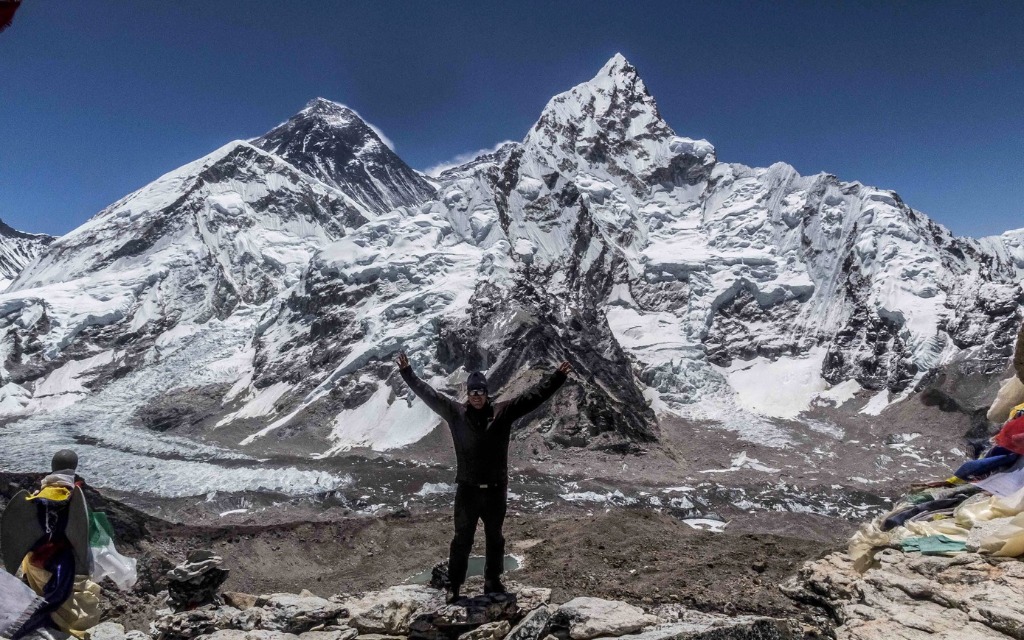
Jiri To Everest Base Camp Trek 22 Days
Tour Gallery
Overview
Jiri to Everest Base Camp Trek: Rediscovering the Classic Himalayan Trail
The allure of the Himalayas has captivated adventurers and trekkers for decades, offering a mesmerizing blend of towering peaks, pristine landscapes, and a sense of awe-inspiring grandeur.
While the Everest Base Camp trek is renowned worldwide, there exists a less-traveled route that promises a more authentic and challenging experience the Jiri to Everest Base Camp trek.
This classic trail, less frequented by modern trekkers, retraces the footsteps of early Everest expeditions and provides a unique perspective on the Khumbu region.
Historical of Jiri – The Forgotten Gateway
The Jiri to Everest Base Camp trek is a journey steeped in history. Before the advent of Lukla Airport, trekkers and mountaineers would embark on their Everest expeditions from Jiri, a small town in the lower Solu region of Nepal.
This historical trail served as the gateway for the pioneers of Everest, including Sir Edmund Hillary and Tenzing Norgay, who first conquered the world’s highest peak in 1953.
The Trek Itself: A Grueling Yet Rewarding Challenge
Embarking on the Jiri to Everest Base Camp trek is not for the faint of heart. Spanning approximately 150 miles (240 kilometers). This trek demands physical endurance, mental resilience, and a genuine love for the raw beauty of the Himalayas.
The trail winds through picturesque villages, dense rhododendron forests, and high-altitude landscapes, offering diverse experiences for those willing to take on the challenge.
The trek begins in Jiri, situated at an altitude of 1,905 meters (6,250 feet). Trekkers gradually ascend through the Solu region, passing through charming villages like Shivalaya, Bhandar, and Sete.
The initial days involve traversing terraced fields and crossing suspension bridges that span deep river gorges.
Cultural Immersion: Villages and Monasteries
One of the highlights of the Jiri to Everest Base Camp trek is the opportunity to immerse oneself in the rich Sherpa culture. As trekkers ascend the trail, they encounter traditional villages where life has remained unchanged for generations.
Tea houses along the route provide a glimpse into the daily lives of the Sherpa people, known for their warmth and hospitality.
In route, trekkers can explore ancient monasteries, such as the Thupten Chholing Monastery in Junbesi, which reflects the deep spiritual connection of the region.
The sound of prayer flags fluttering in the wind and the sight of intricately carved mani walls add a spiritual dimension to the trek, creating a memorable cultural experience.
Scenic Beauty: From Rolling Hills to Alpine Peaks
The Jiri to Everest Base Camp trail offers a diverse array of landscapes that showcase the natural beauty of the Khumbu region.
Trekkers traverse rolling hills covered in lush greenery, pass through dense forests adorned with vibrant rhododendron blooms (especially during spring), and eventually find themselves above the tree line in the stark, high-altitude landscapes.
One of the highlights is the crossing of the Lamjura La pass, standing at an elevation of 3,530 meters (11,581 feet). From this vantage point, trekkers are treated to panoramic views of the surrounding mountains, providing a taste of the grandeur that awaits them as they approach Everest Base Camp.
Meeting the Everest Trail
After days of trekking through remote landscapes, the Jiri to Everest Base Camp trail intersects with the more popular Lukla to Everest Base Camp route at the village of Nunthala.
This junction marks the transition from the less-traveled path to the bustling trail that leads to the iconic Everest Base Camp.
From Nunthala, trekkers continue towards familiar landmarks such as Namche Bazaar, Tengboche Monastery, and Dingboche, gradually gaining altitude and acclimatizing to the thinning air. The journey becomes a blend of solitude and camaraderie as trekkers share tales of their unique experiences with those who have taken the more conventional route.
Challenges and Rewards
The Jiri to Everest Base Camp trek has its challenges. The extended duration, ranging from 18 to 21 days, demands more physical fitness and mental stamina than the more direct Lukla route.
Trekkers must navigate varied terrain, including steep ascents and descents, rocky paths, and high mountain passes.
However, it is precisely these challenges that make the journey so rewarding. The accomplishment of completing the entire trail, the intimate connection with local communities, and the opportunity to witness the Himalayas in their unfiltered glory create memories that last a lifetime.
Preserving the Trail: Responsible Tourism
As the Jiri to Everest Base Camp trek gains recognition, it is essential to approach it with a mindset of responsible tourism. The region’s fragile ecosystem and the unique culture of its inhabitants require careful stewardship.
Trekkers are encouraged to minimize their environmental impact by adhering to Leave No Trace principles, supporting local businesses, and respecting the customs and traditions of the Sherpa communities.
Conclusion
The Jiri to Everest Base Camp trek offers a chance to step back in time, retracing the footsteps of Everest’s early pioneers while forging a connection with the authentic spirit of the Khumbu region.
Though physically demanding, this less-traveled path rewards trekkers with unparalleled cultural experiences, breathtaking landscapes, and a sense of achievement beyond reaching Everest Base Camp.
For those seeking a trek that transcends the conventional, the Jiri to Everest Base Camp trail beckons as a classic Himalayan adventure, where the journey becomes as significant as the destination.
Trip Highlights
- ☞Jiri is known as the Switzerland of Nepal.
- ☞Jiri to Everest is the classic route to the mountain.
- ☞Over 100,000 trekkers visit Everest Base Camp every year.
- ☞Sherpas are also called the “Kings of the Himalayas.”
- ☞You can use high-speed internet even at the Everest Base Camp.
- ☞Mount Everest is called Sagarmatha in Nepali and Chomolungma in Tibetan.
- ☞Sir Edmund Hillary and Tenzing Norgay Sherpa initiated this classic trek route.
What's Included
Included Services
- ✓Airport pickup and drop services on a private vehicle
- ✓3 Nights hotel Free with Breakfast.
- ✓kathmandu to jiri through Roadways (bus jeep) and lukla to kathmandu with flight (Airways)
- ✓Food all along the trip(Breakfast, Lunch, Dinner and a cup of coffee or tea) and accommodations during the trip in hotels with family environment
- ✓One licensed trekking guide speaking English, Chinese, Korean, or Hindi, and Nepali
- ✓Transportation, food, accommodation and insurance of Guide during the trip
- ✓Down jacket, all-season sleeping bag, duffel bag and trekking map(in case if you dont have your own. Down jacket, sleeping bag and duffel bag must be returned after completion of the trip)
- ✓First Aid Medical Kit(Carried by the guide)
- ✓All the required permits and paperworks
- ✓Welcome or farewell dinner in Kathmandu at a cultural restaurant(complimentary)
- ✓A nation-wide operated Mobile SIM Card and a map of the trekking region.
- ✓Porter
Optional Addons
Excluded Services
- ✗International Airfare
- ✗Visa Charges
- ✗Hotel Expenses(In Kathmandu)
- ✗Your travel and medical insurance
- ✗Personal Expenses such as shopping, bar bills, hot shower, telephone, laundry, titbits etc
- ✗Food and accommodations in Kathmandu
- ✗Services not mentioned or not promised by the agent/agency
- ✗Emergency expenses such as expenses on charted helicoptor.
Detailed Itinerary
More Information
How difficult is the Jiri to Everest classic trek?
The Jiri to Everest Classic trek is a moderate trek. What makes it challenging is that the trek itself goes on for 22 days. It really may be taxing for a normal human to trek for 22 days. Moreover, the trail involves ascending and descending through steep hills, valleys, and ridges.
With long hours of walking per day, some days even require 7-8 days of trekking. You must have a good fitness level and prior trekking experience to undertake this trek.
What are the main highlights of the Jiri to Everest classic trek?
Jiri to Everest classic trek is one of the best routes that Nepal has to offer for trekkers and hikers. Taking you all the way around to the base camp of the world’s highest peak. Some of its highlights are:
- Visiting Sherpa villages of the Solukhumbu region
- Exploring the rich cultural heritage of the region
- Stunning views of the Himalayas, and some great peaks
- Crossing high Mountain Passes
- The Everest Base Camp
These were just some of the highlights that this trek offers, with small things that add up to make your experience a wholesome one. A great trek overall.
Why choose the Jiri to Everest Base Camp trek over the Lukla route?
The Jiri to Everest Base Camp trek offers a more authentic and less crowded experience than the Lukla route. It retraces the historical footsteps of early Everest expeditions and provides a diverse range of landscapes and cultural encounters.
How long does the Jiri to Everest Base Camp trek take to complete?
The duration of the trek typically ranges from 18 to 22 days, depending on the specific itinerary chosen. This longer timeframe allows for gradual acclimatization and a more immersive experience.
What is the best time of year to undertake this trek?
The best time for the Jiri to Everest Base Camp trek is during the pre-monsoon (spring) and post-monsoon (autumn) seasons. April to June and September to November offer stable weather conditions and clear mountain views.
Is the Jiri to Everest Base Camp trek more challenging than the Lukla route?
Yes, the Jiri to Everest Base Camp trek is considered more challenging due to its longer duration and varied terrain. Trekkers should be prepared for steep ascents and descents, rocky paths, and higher physical demands.
Are permits required for the Jiri to Everest Base Camp trek?
Yes, trekkers must obtain permits for the Jiri to Everest Base Camp trek. The required permits include the Sagarmatha National Park Entry Permit and the Khumbu Pasang Lhamu Rural Municipality Entrance Permit.
What is the cost of the Jiri to Everest classic trek and what does it include?
The trek from Jiri to Everest, being a long trek comes with a great price tag too. With the price ranging from 2200-2500 USD per person. This cost includes permits, transportation, accommodation, meals, guides, and porter fees.
However, when trekking with an agency like Nepal Lion Treks, we offer some of the best prices here in Nepal with quality services. Do let us help you have a great and safe experience in the Himalayas.
How do I acclimatize during the trek?
The trek includes gradual ascents, allowing for natural acclimatization. Rest days are strategically incorporated in villages like Namche Bazaar and Dingboche, allowing trekkers to adjust to the increasing altitude.
What is the accommodation like along the Jiri to Everest Base Camp trail?
Tea houses and lodges are available along the route, offering basic but comfortable accommodation. Trekkers should be prepared for shared facilities and embrace the simple mountain lifestyle.
Can I hire a guide and porter for the trek?
Hiring a guide and porter is recommended for a smoother experience. A guide helps with navigation and cultural insights and ensures safety, while a porter assists with carrying heavy backpacks, allowing trekkers to enjoy the journey more comfortably.
Are there medical facilities along the trail?
Basic medical facilities are available in larger villages, but carrying a personal first aid kit is advisable. In case of severe health issues, evacuation to lower altitudes may be necessary.
How can I contribute to responsible tourism during the Jiri to Everest Base Camp trek?
Travel responsibly by adhering to Leave No Trace principles, supporting local businesses, and respecting the culture and customs of the Sherpa communities. Minimize waste, carry reusable items, and be mindful of the environmental impact.



